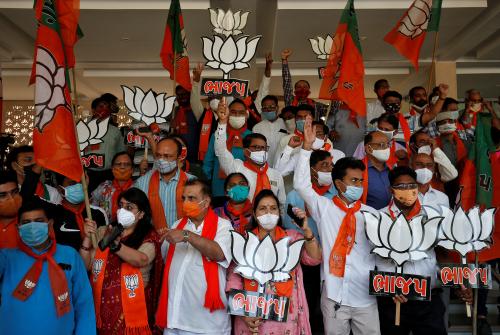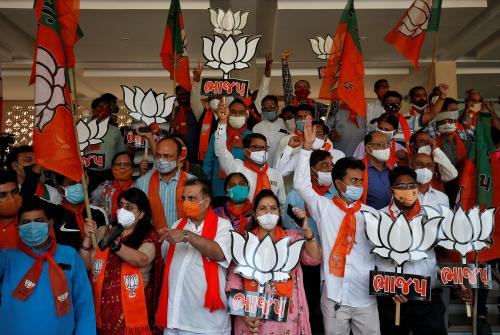Content from the Brookings Institution India Center is now archived. After seven years of an impactful partnership, as of September 11, 2020, Brookings India is now the Centre for Social and Economic Progress, an independent public policy institution based in India.
“Electronic Voting Machines (EVMs) replaced paper ballots in elections across India from 1998 to 2001 to safeguard against electoral fraud. Since then, research studies have shown evidence of EVMs reducing fraud by looking at various metrics. With the 2019 Lok Sabha elections around the corner, the robustness of the electoral process is under debate. Major political parties have announced that they will reform electronic voting, including matching 50% of the EVMs against the physical count of the voting slips in the corresponding VVPATs (Voter verifiable paper audit trail). This differs from the current practice of verification which does the matching for only one polling booth in an assembly/Lok Sabha constituency. Our series of blogs on EVMs will look at past research by Brookings scholars and how EVMs have had an effect not only on electoral fraud, but also on other measures of democracy and development.”
Sisir Debnath, Mudit Kapoor and Shamika Ravi go beyond a discussion of election outcomes in their paper, The Impact of Electronic Voting Machines on Electoral Frauds, Democracy, and Development (2017), to look at the effect of transparency in voting through EVMs on the delivery of public goods within a constituency. Focusing specifically on electricity provisioning in India, and using nighttime luminosity as an innovative proxy, they found an improvement in the provisioning of electricity as elections approached in constituencies that voted electronically.
In an earlier blog, we used results from Debnath, Kapoor and Ravi’s analysis of intra-state comparisons between constituencies to show how EVMs curb electoral fraud. Incumbent politicians often manipulate fiscal and macroeconomic policies to improve their chances of re-election[i]. A transparent election may induce the incumbent politician to align with the preferences of the median voter[ii]. Members of legislative assemblies have less discretionary power and access to state funds, but they routinely exploit state-controlled distribution companies to increase their chances of re-election. One such way in which politicians may exploit this is through electricity and its provision.
A large fraction (41%) of electricity production in India is controlled by public utility companies, often called State Electricity Boards. They are also responsible for distribution and transmission. Electricity is important for industry, agriculture and household use and is therefore an important issue during state elections. The managers of these institutions are accountable to elected officials and politicians can thus wield their influence to control and manipulate the distribution of electricity to tilt election outcomes in their favor[iii]. The authors perform an indirect test on the effect of transparency in elections by studying how introducing electronic voting machines affected electricity provisioning in state assembly elections. The authors show that EVMs led to significant reduction in election fraud and thereby made electoral outcomes truly representative of public preferences. Given the election promises of increased and steady electricity supply, the study explores the impact of EVMs on electricity and finds significant positive impact.
The authors show that EVMs led to significant reduction in election fraud and thereby made electoral outcomes truly representative of public preferences.
The authors take data from 1992 till 2007 of nightlights satellite images from NASA’s Defense Meteorological Satellite Programs Operational Linescan System. Each pixel, which corresponds to approximately one square kilometer, is encoded with its annual average brightness on a scale from 0 to 63 after discarding cloud cover and fleeting lights (such as forest fires). The brightness of night lighting, hereafter referred to as luminosity, is used as a proxy for consumption of electricity in this case. They combine the luminosity data with state assembly constituency boundary maps to extract annual luminosity at the constituency level.
Results of analysing the data for luminosity at the constituency level show that while average supply of electricity went up, there are systematic trends over the years within the election cycle. Electricity provision falls one year after state elections are held with voting machines, and then rises in the second, third and fourth years, by 9.2%, 12%, and 23% respectively. Thus electricity provisioning increases as the next election draws nearer and is highest in the year before the election. Looking at the annual average luminosity for each election cycle, it is found that constituencies enjoy a significantly higher overall supply of electricity when voting machines are used as compared to paper ballots. The provision of electricity improves over time, and the effect is strongest for the year just before the subsequent election.
Night-time Lights in India with Assembly Constituency Boundary
Panel A: 1992

Panel B: 2007

[i] Drazen, A. (2001). The Political Business Cycle After 25 Years. In NBER Macroeconomics Annual 2000, Volume 15, NBER Chapters, National Bureau of Economic Research, Inc, pp. 75–138.
Alesina, A., Roubini, N. and Cohen, G. (1997). Political Cycles and the Macroeconomy. Cambridge, MA: MIT Press.
[ii] Meltzer, A. H. and Richard, S. F. (1981). A Rational Theory of the Size of Government. Journal of Political Economy, 89 (5), 914–27.
[iii] Baskaran T., Min B., Uppal Y. (2014) Election Cycles and Electricity Provision: Evidence from a Quasi-experiment with Indian Bye-elections.


Commentary
The surprising link between EVMs and electricity
May 1, 2019